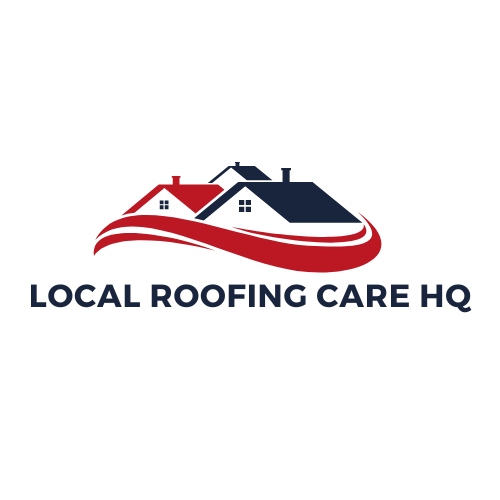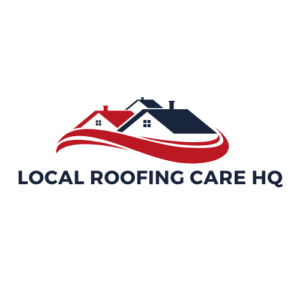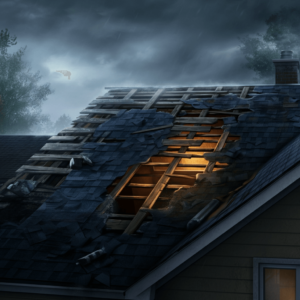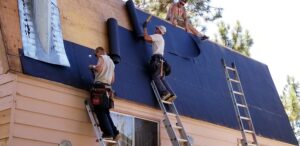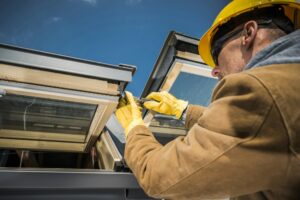A leaky roof can transform a comfortable home into a situation marked by significant water damage if not addressed promptly.
Whether one is observing water stains on the ceiling or detecting a musty odor, early recognition of these signs is essential.
This guide aims to assist individuals in identifying leaks, offering effective repair solutions, and recommending preventative measures to maintain the roof in optimal condition.
It is advisable not to wait for the next rainstorm to take action; safeguarding your home from potential damage is paramount.
Signs of a Leaky Roof
Identifying the signs of a leaky roof is essential for homeowners seeking to maintain the structural integrity and longevity of their roofing systems.
A minor leak can result in considerable moisture damage, affecting not only the roof itself but also the insulation and overall value of the home. Recognizing these signs allows for prompt intervention, which can prevent expensive emergency repairs and prolong the lifespan of roofing materials.
Regular roof inspections are imperative, especially following severe weather events, to identify potential issues before they develop into more serious problems. Homeowners should remain vigilant regarding various indicators to ensure that effective maintenance and repair techniques are implemented.
1. Water Stains on Ceiling or Walls
Water stains on ceilings or walls are often the most visible indicators of a leaky roof, signaling potential moisture damage that necessitates immediate attention.
These unsightly marks not only diminish the aesthetic appeal of a home but also indicate a more profound issue that could result in significant structural damage if left unaddressed.
Such stains may arise from various factors, including clogged gutters, broken shingles, or damaged flashing, all of which can permit water to infiltrate the interior spaces.
This underscores the importance for homeowners to prioritize a comprehensive roof inspection, as identifying the source of the leaks is essential for effective leak detection.
By understanding these underlying issues, homeowners can implement appropriate maintenance solutions, thereby safeguarding their property against further deterioration and ensuring long-lasting protection from water damage.
2. Damp or Musty Odor
A damp or musty odor in a residence can signify underlying moisture issues related to roof leaks, necessitating prompt investigation to prevent the development of mold.
The presence of such odors may serve as an initial indicator of a more significant issue, as these scents commonly signal water intrusion or trapped moisture in concealed areas.
Homeowners should conduct thorough inspections of their roofs for signs of wear, such as damaged shingles or flashing, which could compromise the integrity of the roofing system. Upon identifying potential leaks, it is essential to examine the interior for water stains, discoloration, or mold patches.
To mitigate risks, it is advisable to routinely check gutters and downspouts to ensure proper water flow and consider investing in quality ventilation systems, which play a critical role in preventing mold proliferation. Regular maintenance and vigilance can significantly enhance the longevity of roofing and inhibit mold growth.
3. Visible Water Dripping or Pooling
Visible water dripping or pooling is a clear indication of a leaky roof that necessitates immediate attention to prevent extensive property damage.
Failure to address such signs may result in more severe complications, including mold growth, structural weakening, and costly repairs. This issue often arises from various sources, such as worn-out shingles, damaged flashing, or clogged gutters.
Each of these factors underscores the importance of regular roofing maintenance and repair practices to ensure the integrity of the roof over time. Timely action is essential, as the longer a leak persists, the greater the potential for damage, which may ultimately impact walls, insulation, and even the foundation.
How to Fix a Leaky Roof
Addressing a leaky roof necessitates a systematic approach to identify the source of the leak and implement suitable repair techniques to ensure enduring results.
Homeowners may opt for do-it-yourself repairs or seek the expertise of professional contractors, depending on the extent of the damage.
Key considerations include the use of high-quality roofing materials, such as sealants and flashing, to effectively waterproof the affected area.
Furthermore, an understanding of local regulations and building codes is essential for making safe and compliant repairs while preserving the aesthetic appeal of the property.
1. Identify the Source of the Leak
Identifying the source of a leak is a critical initial step in effectively addressing a leaky roof, as it determines the necessary repair techniques.
Employing a combination of visual inspections and specialized tools can significantly enhance the leak detection process. Visual inspections typically involve examining the roof’s surface for signs of wear, such as missing shingles or damaged flashing. Additionally, experts may utilize infrared cameras to detect moisture trapped beneath the roofing materials.
Integrating these methods not only aids in pinpointing the precise location of leaks but also underscores the importance of accurate damage assessment in roof maintenance and repair. This comprehensive approach facilitates the development of an appropriate course of action to ensure long-term structural integrity and prevent further degradation.
2. Make Temporary Repairs
Making temporary repairs can provide immediate relief from a leaky roof, effectively preventing further moisture damage until permanent solutions are implemented.
In circumstances where swift action is imperative, utilizing the appropriate roofing tools can significantly enhance the effectiveness of temporary measures. Techniques such as applying tar paper over the affected area or employing sealants to fill in gaps can establish a waterproof barrier.
Homeowners should collect essential materials, including:
- Roofing tape
- Tar
- Heavy-duty plastic sheeting
to efficiently seal leaks. Additionally, utilizing a sturdy ladder and wearing protective gear ensures that these emergency repairs can be conducted safely. Proactively addressing roofing maintenance not only minimizes immediate risks but also prepares homeowners for potential future challenges.
3. Replace Damaged Shingles or Flashing
Replacing damaged shingles or flashing is essential for restoring the integrity of the roof and preventing future leaks, thereby ensuring the longevity of the roofing system.
Selecting the appropriate roofing materials is a critical initial step in this replacement process. Homeowners should carefully consider factors such as durability, weather resistance, and aesthetic appeal when choosing shingles, with options available in asphalt, wood, or metal.
Equally important is the installation of flashing, which serves as a barrier against moisture. Adhering to proper installation techniques, including overlapping seams and utilizing high-quality sealants, can significantly enhance the roof’s overall performance.
Moreover, understanding the warranties associated with these materials can provide homeowners with peace of mind and protection for many years to come.
4. Clear Debris from Gutters and Downspouts
Regularly clearing debris from gutters and downspouts is essential for maintaining proper drainage and preventing water accumulation, which can lead to roof leaks.
A well-maintained drainage system is critical for extending the lifespan of roofing materials, ensuring their effectiveness against environmental elements. When gutters and downspouts become clogged, water cannot flow freely, leading to potential overflow or pooling on the roof surface.
This stagnant water can deteriorate roofing materials over time, increase the risk of mold growth, and compromise the structural integrity of the building.
By prioritizing seasonal maintenance, homeowners can protect not only their roofs but also their entire property, thereby preserving its value and enhancing overall aesthetics.
5. Apply Roof Sealant or Tape
Applying roof sealant or tape serves as an effective leak-proofing strategy that enhances the waterproofing capabilities of a roofing system, thereby helping to prevent future leaks.
This approach not only extends the lifespan of the roof but also provides an excellent return on investment by reducing long-term repair costs. Homeowners can easily incorporate these products into their regular maintenance routines, ensuring that their roofing remains in optimal condition.
The application process generally entails thoroughly cleaning the surface, followed by the careful application of the sealant or tape to specific areas vulnerable to moisture infiltration.
Furthermore, integrating these roofing technologies with seasonal inspections significantly enhances their effectiveness, bolstering the structure against weather-related wear and tear while maintaining an energy-efficient barrier.
6. Call a Professional for Extensive Damage
For significant damage, it is imperative to engage professional contractors to conduct a comprehensive assessment and implement effective solutions for roofing issues.
These experts not only possess specialized knowledge and experience but also offer valuable insights regarding the appropriate materials suited for specific circumstances. Early engagement with roofing services can prevent minor issues from developing into costly repairs in the future.
During a consultation, individuals can anticipate a thorough evaluation of their roof’s condition, including a candid discussion about potential costs and a detailed plan for addressing the identified problems.
By relying on professionals, homeowners can be assured that they are making informed decisions that will enhance the longevity and integrity of their roofing systems.
Preventing Future Leaks
Preventing future leaks necessitates the implementation of proactive measures and the establishment of a consistent roof maintenance schedule, thereby enhancing the longevity and performance of the roofing system.
Regular inspections are critical for identifying early signs of wear, while adherence to proper maintenance routines ensures that roofing materials remain in optimal condition.
Furthermore, seasonal maintenance tasks, including the clearing of gutters and the assessment of attic ventilation, are essential for minimizing the risk of moisture damage and promoting energy efficiency within the home.
1. Regularly Inspect and Maintain Your Roof
Regular inspection and maintenance of your roof are essential for identifying potential issues and ensuring structural integrity over time.
A well-structured maintenance schedule may include seasonal inspections conducted by a qualified professional who can assess for signs of wear, loose shingles, and debris accumulation. During these evaluations, it is important to examine flashing, gutters, and any junctions where the roof interfaces with other structures. Proactively addressing these areas can help to prevent costly repairs in the future.
This level of vigilance not only extends the lifespan of the roof but also enhances the overall energy efficiency of the home, helping to keep utility bills manageable. Consistently prioritizing these inspections ensures that minor problems are addressed before they develop into significant challenges.
2. Keep Gutters Clean and Clear
Maintaining clean and clear gutters is essential for ensuring proper drainage and preventing water accumulation on the roof, which can lead to leaks and structural damage.
Regular maintenance not only safeguards the foundation of a home but also guarantees the effective functioning of drainage systems. Homeowners should aim to inspect their gutters at least twice a year, particularly during the fall and spring, to identify blockages caused by leaves, twigs, and other debris.
By using a sturdy ladder, one can safely access the gutters and employ a scoop or garden trowel to remove any obstructions. Flushing the gutters with water can help pinpoint areas that may still retain debris or require more thorough cleaning.
This proactive approach enhances the longevity of roofing materials and minimizes the potential for costly repairs, ensuring that water flows freely away from the home.
3. Trim Overhanging Tree Branches
Trimming overhanging tree branches represents a proactive approach to roof maintenance, effectively preventing damage from falling limbs and minimizing debris accumulation on the roof.
This essential practice not only protects the integrity of the roof but also significantly contributes to its longevity. By managing the proximity of trees, homeowners can mitigate the risk of moisture-related issues, such as mold and rot, which often result from trapped leaves and debris.
Maintaining a clear space facilitates improved air circulation, aiding in moisture evaporation and thereby enhancing the overall durability of roofing materials.
Ultimately, regular tree maintenance not only supports a healthier roof but also promotes structural safety, helping to prevent costly repairs in the future.
4. Use High-Quality Roofing Materials
Utilizing high-quality roofing materials is essential for ensuring the durability and performance of a roofing system, as it provides effective protection against leaks and adverse weather conditions.
When evaluating options such as asphalt shingles, metal roofing, or environmentally friendly alternatives like bamboo or recycled tiles, the selection of materials significantly influences the roof’s lifespan and energy efficiency.
Investing in premium products not only enhances resilience against severe elements but also optimizes insulation, thereby reducing energy consumption over time.
Given the growing emphasis on sustainability, choosing roofing types that incorporate eco-friendly materials can diminish one’s carbon footprint, thereby contributing to a healthier environment.
Homeowners may discover that these choices are not merely advantageous as a one-time expense, but also yield long-term savings through reduced utility bills and maintenance costs.
Frequently Asked Questions
What are some common causes of a leaky roof?
Some common causes of a leaky roof include damaged or missing shingles, clogged gutters, cracked flashing, and inadequate ventilation.
How can I locate the source of a roof leak?
The best way to locate a roof leak is to inspect both the interior and exterior of your roof for any visible signs of damage, such as water stains or missing shingles. You can also use a hose to simulate rain and see where the water is entering your roof.
Can I fix a leaky roof myself?
It is not recommended to attempt fixing a leaky roof on your own, as it can be dangerous and result in further damage if not done properly. It is best to hire a professional roofing contractor with experience in repairing leaks.
What should I do if I notice a leak in my roof?
If you notice a leak in your roof, it is important to take immediate action. Cover the affected area with a tarp to prevent further damage and contact a roofing contractor for repair services as soon as possible.
How much does it cost to fix a leaky roof?
The cost of fixing a leaky roof can vary depending on the extent of the damage, the type of roofing material, and the location of the leak. It is best to get a quote from a professional roofing contractor for an accurate estimate.
What can I do to prevent future roof leaks?
To prevent future roof leaks, it is important to regularly inspect your roof for any signs of damage and address them promptly. Keep your gutters clean, trim any overhanging branches, and make sure your roof is properly ventilated to prevent moisture buildup.
